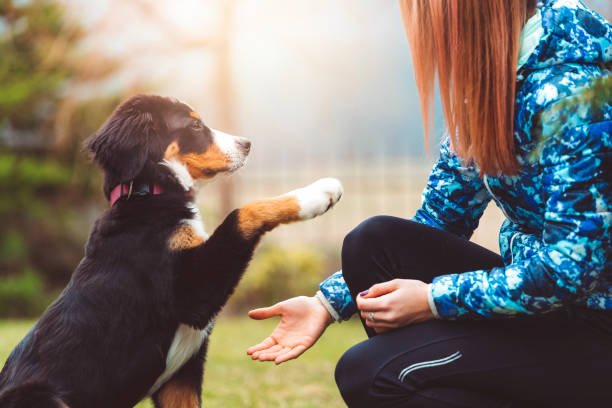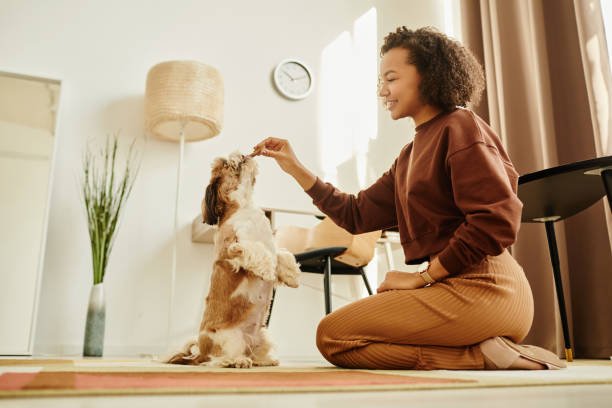Bringing home a new puppy is exciting — and sometimes overwhelming. If you’ve been searching for how to train a puppy the right way, this guide will give you the essential steps to turn those chaotic first weeks into calm, confident progress.
With consistent routines, short daily sessions, and positive reinforcement, you can teach your puppy good manners while building a loving bond that lasts a lifetime.

Why Understanding Puppy Training Matters
Professional trainers and behaviorists agree that positive reinforcement is the most effective method when learning how to train a puppy. This means rewarding your pup for doing things right rather than punishing mistakes.
According to the American Kennel Club (AKC) and Humane Society, consistency, patience, and clear communication are the keys to successful training.
1. Start with a Simple Routine
Puppies thrive on structure. Set fixed times for meals, bathroom breaks, naps, and playtime. A predictable schedule helps your pup understand what’s expected and speeds up the learning process.
2. Potty Training Basics
Potty training is often the biggest concern for new owners. Take your puppy outside after waking, eating, or playing — and reward them immediately after they go in the right spot.
If you’re wondering how to train a puppy to potty consistently, remember: same spot, same timing, and lots of praise. Never punish accidents — just clean up and try again.
3. Crate Training Builds Confidence
A crate isn’t a cage; it’s a safe space. Introduce it slowly by feeding your puppy meals inside the crate and leaving the door open at first. Gradually increase time spent inside with comfort toys.
The Humane Society’s guide explains crate training as one of the best ways to teach your puppy patience and independence.
4. Teach Basic Commands Early
Start with sit, come, down, and leave it. These simple commands create the foundation for good manners.
Use treats, praise, and repetition. When you’re practicing how to train a puppy to come when called, begin indoors in a quiet environment, then move to more distracting areas as your puppy improves.
5. Socialization Is Non-Negotiable
Exposing your puppy to new people, places, and sounds early prevents fear and aggression later in life. Invite friends over, take short car rides, or visit dog-friendly parks once your vet approves.
Socialization is one of the most critical aspects of how to train a puppy for confidence and emotional stability.
6. Bite Inhibition and Mouthing
Puppies explore with their mouths, but biting must be controlled early. Redirect their attention to a toy, and if biting continues, pause play briefly. This teaches bite inhibition — a vital step in learning how to train a puppy to interact gently.
7. Use Positive Reinforcement Always
Reward desired behaviors with treats, toys, or verbal praise. Ignore unwanted actions rather than punishing them. This method builds trust and speeds up learning.
Remember: a confident puppy learns faster than a scared one. Positive reinforcement is the golden rule for anyone mastering how to train a puppy.
8. Keep Sessions Short and Fun
Five to ten minutes of focused training, several times a day, works best. Puppies have short attention spans, so end every session on a positive note.
9. Troubleshooting Common Problems
If your puppy regresses or resists training, reduce distractions and simplify commands. Be patient — puppies are learning constantly.
If you’re stuck, resources like Pupford’s Free Puppy Training Guides offer detailed breakdowns and short video lessons for beginners.
10. Know When to Ask for Help
If consistent effort isn’t working, seek professional help. A certified trainer can evaluate your approach and guide you toward success.
At Train My Pup Now, we specialize in personalized training programs that help you and your puppy communicate better and build lasting habits.
👉 Book your free 15-minute consultation today and get a custom puppy training plan made for your lifestyle.
🐶 Quick Puppy Training Checklist
✅ Create a routine (feed, potty, play, nap)
✅ Begin crate training early
✅ Practice short 5-minute sessions
✅ Reward calm, polite behavior
✅ Socialize with people, sounds, and other pets
✅ Teach sit, come, down, and leave it
Trusted Resources for Puppy Parents
- American Kennel Club – Puppy Training Basics
- Humane Society – Crate Training Guide
- Pupford – Free Puppy Training Guides
Final Thoughts
Training a puppy takes time, but it’s also one of the most rewarding things you’ll ever do. By staying patient, consistent, and positive, you’ll discover that how to train a puppy isn’t just about obedience — it’s about building trust, love, and lifelong friendship.
Ready to take the next step?
👉 Start your personalized puppy training journey today with Train My Pup Now!
